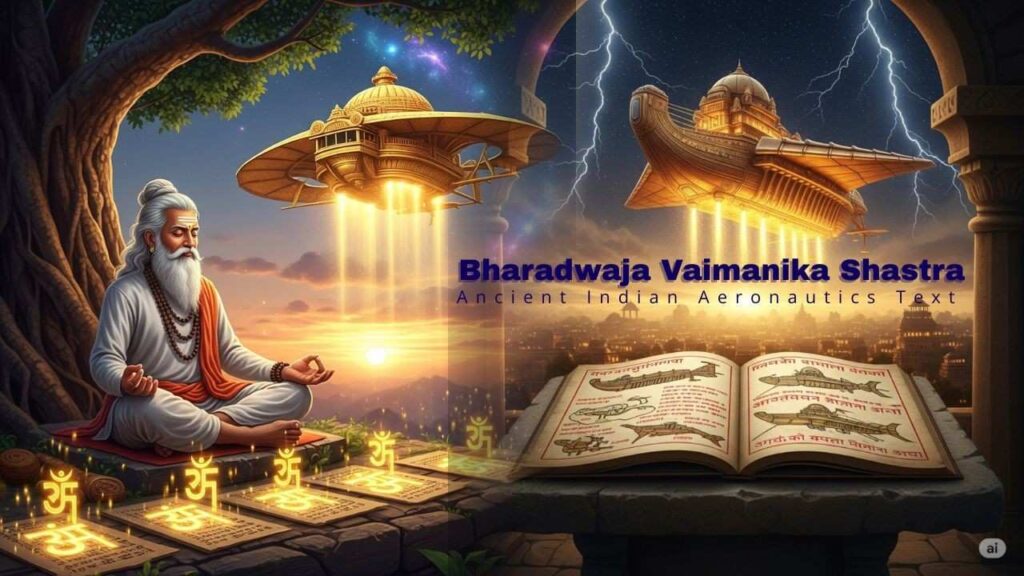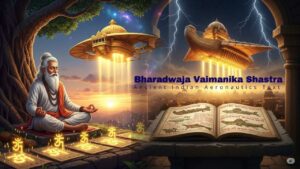Bharadwaja Vaimanika Shastra – Ancient Indian Aeronautics Text

The Bharadwaja Vaimanika Shastra is one of the most mysterious and fascinating texts from ancient India. It is believed to be an advanced treatise on aeronautics, attributed to the sage Maharishi Bharadwaja. This ancient manuscript has intrigued scholars, scientists, and conspiracy theorists alike. The Bharadwaja Vaimanika Shastra is often cited as evidence that ancient Indian civilizations had access to technology far ahead of their time, including flying machines called Vimanas.
In this comprehensive article, we will dive deep into the Bharadwaja Vaimanika Shastra, exploring its history, contents, controversies, and the ongoing debate about whether ancient India truly had knowledge of advanced aviation. With increasing interest in India’s ancient sciences, the Bharadwaja Vaimanika Shastra continues to be a hot topic in both academic and alternative history circles.
Origin of Bharadwaja Vaimanika Shastra
The Bharadwaja Vaimanika Shastra is said to be authored by the great sage Maharishi Bharadwaja, one of the seven ancient rishis (Saptarishi) of India. He was known for his deep knowledge of science, medicine, and technology. The Bharadwaja Vaimanika Shastra was supposedly channeled or rediscovered in the early 20th century by Pandit Subbaraya Shastry, a Sanskrit scholar from India, who claimed he received the knowledge through yogic clairvoyance.
According to Shastry, the manuscript was a transmission of the original Bharadwaja Vaimanika Shastra, which had been lost over the centuries. He wrote down over 3000 shlokas (verses) based on this ancient knowledge. The manuscript was later published in 1959 under the name “Vaimanika Shastra” and has since been the subject of intense study and debate.
What is Inside the Bharadwaja Vaimanika Shastra?

The Bharadwaja Vaimanika Shastra is divided into multiple chapters that describe the construction, operation, and types of ancient flying machines or Vimanas. It goes into astonishing detail about aerial vehicles, materials used in construction, flight maneuvers, pilot clothing, food for pilots, and more. Some key aspects of the Bharadwaja Vaimanika Shastra include:
1. Types of Vimanas
The text describes several types of Vimanas, including:
-
Shakuna Vimana
-
Sundara Vimana
-
Rukma Vimana
-
Tripura Vimana
Each type has unique characteristics, designs, and purposes. For example, the Shakuna Vimana resembles a bird and uses flapping wings, while the Tripura Vimana is a massive, multi-layered flying palace.
2. Construction Materials
The Bharadwaja Vaimanika Shastra talks about materials that were supposedly lighter than modern metals, heat-resistant, and capable of withstanding high-speed flight. It mentions elements unknown to modern chemistry and describes alloys with unique properties.
3. Propulsion Systems

One of the most fascinating parts of the Bharadwaja Vaimanika Shastra is its explanation of propulsion. While it doesn’t describe modern jet engines, it references energy sources like solar power, mercury engines, and anti-gravity forces. The propulsion principles described seem magical yet are surprisingly systematic.
4. Pilot Training and Diet
The text even outlines the mental, spiritual, and physical training required for a pilot. According to the Bharadwaja Vaimanika Shastra, a pilot should have high mental discipline and follow a strict vegetarian diet. It also recommends certain yogic practices to improve reaction times and mental clarity.
Scientific Analysis of Bharadwaja Vaimanika Shastra
Several scientists and engineers have studied the Bharadwaja Vaimanika Shastra over the years. In 1974, a study was conducted by researchers at the Indian Institute of Science (IISc), Bangalore, who concluded that the designs described in the text were not aerodynamically viable. The report claimed the aircraft would not be able to fly with the provided schematics.

However, many scholars argue that the Bharadwaja Vaimanika Shastra is symbolic and not meant to be taken literally. Others suggest that the knowledge was so advanced that we still don’t have the technological context to understand or replicate it. Despite the criticism, the Bharadwaja Vaimanika Shastra continues to be a source of inspiration for researchers interested in ancient Indian science.
Modern Interpretations and Popular Culture
In recent years, the Bharadwaja Vaimanika Shastra has gained renewed attention. With the popularity of shows, books, and documentaries focused on ancient aliens, lost civilizations, and Vedic science, the Bharadwaja Vaimanika Shastra is often featured as evidence of ancient Indian technological superiority.
Popular authors and YouTubers discuss how the Vimanas described in the Bharadwaja Vaimanika Shastra might have been anti-gravity aircrafts, UFOs, or even inter-dimensional crafts. Whether or not these claims are scientifically provable, they have captured the imagination of millions worldwide.
The Relevance of Bharadwaja Vaimanika Shastra Today
Why is the Bharadwaja Vaimanika Shastra so important today? It reflects the visionary imagination and scientific curiosity of ancient Indian sages. Even if not all content is practically applicable, the document serves as a window into India’s lost knowledge systems.
It encourages modern researchers to look beyond conventional science and explore alternative models of technology, energy, and consciousness. The Bharadwaja Vaimanika Shastra acts as a bridge between ancient wisdom and futuristic exploration.
Controversies Around Bharadwaja Vaimanika Shastra
There are many controversies surrounding the Bharadwaja Vaimanika Shastra. Some critics claim it’s a modern forgery. Others argue that the knowledge is too symbolic or metaphorical to be practical. There are even debates about whether Maharishi Bharadwaja actually authored the text.
Despite these controversies, the Bharadwaja Vaimanika Shastra has become a topic of serious academic debate and pop-culture speculation. While the mainstream scientific community remains skeptical, alternative historians and Vedic scholars continue to defend its authenticity.
Comparing Bharadwaja Vaimanika Shastra to Other Ancient Texts
The concept of flying machines isn’t limited to the Bharadwaja Vaimanika Shastra. Other ancient Indian texts like the Mahabharata, Ramayana, and Samarangana Sutradhara also mention Vimanas. However, the Bharadwaja Vaimanika Shastra is unique because it offers technical details and design schematics.
This has led to theories that ancient Indian civilizations were technologically advanced, possibly even more so than modern humanity in some aspects. The Bharadwaja Vaimanika Shastra supports the notion that ancient knowledge systems were far from primitive.
Who Wrote Vaimanika Shastra? The Truth Behind the Bharadwaja Vaimanika Shastra
This mysterious Sanskrit text claims to describe ancient Indian aircraft—vimanas—with startling technical detail. But who actually wrote the Bharadwaja Vaimanika Shastra? Was it the sage Bharadwaja thousands of years ago? Or was it a modern composition wrapped in ancient mystique? Let’s dive deep into the origins, authorship, controversies, and enduring mystery surrounding the Bharadwaja Vaimanika Shastra.
What is the Bharadwaja Vaimanika Shastra?
The Bharadwaja Vaimanika Shastra is a Sanskrit treatise said to deal with the construction, design, and operation of ancient flying machines—commonly referred to as vimanas in Hindu mythology. According to the text, these aircrafts were highly advanced, capable of interplanetary travel, invisibility, and even psychological warfare. The term Vaimanika Shastra literally means “Science of Aeronautics,” and it has become a cornerstone in the world of ancient astronaut theories.
The Claim: Sage Bharadwaja as the Author
The Bharadwaja Vaimanika Shastra is attributed to Maharishi Bharadwaja, one of the most revered sages of ancient India and a prominent figure among the Sapta Rishis. As per traditional beliefs, Bharadwaja had immense knowledge of the Vedas and was proficient in numerous sciences, including Ayurveda, physics, and aeronautics.
Proponents of the text claim that the Bharadwaja Vaimanika Shastra was part of a lost body of scientific knowledge that predates modern aeronautics by millennia. They argue that this text is merely a surviving piece of what was once a vast technological library of Vedic India. According to this narrative, Sage Bharadwaja received the knowledge of vimanas through divine revelation and recorded it in the Bharadwaja Vaimanika Shastra.
The Modern Appearance of the Text
Here’s where the story takes a twist. Despite claims of ancient origin, the Bharadwaja Vaimanika Shastra was first brought to public attention in the early 20th century. In 1952, a manuscript was published in Hindi titled Vaimanika Shastra, supposedly written by Pandit Subbaraya Shastry, who claimed he had “channeled” or received the knowledge through psychic means from Sage Bharadwaja.
Shastry, who lived in Mysore, India, between 1866 and 1940, never physically wrote the manuscript himself. Instead, he dictated it to a stenographer while in a trance-like state. The document he dictated became known as the Bharadwaja Vaimanika Shastra.
The Controversy Around Authorship
The question of who truly authored the Bharadwaja Vaimanika Shastra has been a subject of hot debate. Skeptics argue that Subbaraya Shastry himself was the real author, and the ancient attribution to Sage Bharadwaja is a myth. They claim the entire work is a 20th-century invention, not an ancient Vedic text.
Supporters, on the other hand, maintain that Shastry merely served as a medium through whom the ancient wisdom of Bharadwaja was revived. According to them, the Bharadwaja Vaimanika Shastra existed in subtle planes and was retrieved through divine communication.
Whether you believe in channeling or not, the fact remains that no manuscript of the Bharadwaja Vaimanika Shastra has been found dating prior to the 20th century.
Technical Content of the Bharadwaja Vaimanika Shastra
Regardless of its disputed origin, the Bharadwaja Vaimanika Shastra contains some fascinating content:
-
Detailed descriptions of aircraft known as vimanas
-
Specifications for materials, fuels, and engines
-
Flying techniques and navigation systems
-
War mechanisms and cloaking technologies
The Bharadwaja Vaimanika Shastra even describes 32 secrets of aviation that include concepts like gyroscopic stabilization and solar energy propulsion. Though often seen as pseudo-scientific by mainstream academics, many believe the text to be a coded archive of real technological knowledge.
Scientific Scrutiny
In 1974, a team of scientists at the Indian Institute of Science (IISc) in Bangalore conducted a study to evaluate the technical feasibility of the Bharadwaja Vaimanika Shastra. Their conclusion was scathing. They declared the text unscientific and inconsistent with modern aeronautics. According to them, the aircraft designs described in the Bharadwaja Vaimanika Shastra were aerodynamically unviable and lacked any understanding of flight mechanics.
But the report itself was not without criticism. Many questioned whether the researchers approached the Bharadwaja Vaimanika Shastra with an open mind or if they dismissed it prematurely due to its mystical origin story.
Was Bharadwaja a Real Scientist?
Maharishi Bharadwaja is a central figure in Indian spiritual and intellectual history. His contributions are mentioned in texts like the Rigveda and Ayurveda, and he is believed to have authored treatises on multiple sciences.
Proponents argue that if anyone could write something like the Bharadwaja Vaimanika Shastra, it would be Bharadwaja. They believe that ancient Indian rishis were advanced seers who possessed scientific knowledge far beyond what we credit them for today. In this light, the Bharadwaja Vaimanika Shastra is a forgotten treasure, now resurfacing in modern times.
The Mystery Lives On
Whether it was written by a mystic in trance or transmitted from an ancient sage, the Bharadwaja Vaimanika Shastra continues to fascinate scholars, researchers, and believers. Some view it as a lost Vedic science, others as an inspired fantasy, and still others as a mix of both.
The lack of historical manuscripts and corroborative references in other ancient texts keeps the mystery alive. Yet, the very existence of such a document compels us to reconsider what we think we know about the past—and to keep questioning.
Influence on Modern India
The Bharadwaja Vaimanika Shastra has had a deep cultural impact. It features in documentaries, research papers, and debates about ancient technologies. Indian space and defense enthusiasts often cite it as evidence that the subcontinent had technological prowess long before the industrial era.
Books, websites, and conferences continue to explore the Bharadwaja Vaimanika Shastra, making it a cornerstone of India’s alternative science lore. For many, it represents the glorious and largely forgotten scientific achievements of ancient India.
What are the Types of Vimanas in Bharadwaja’s Vaimanika Shastra?
The ancient Indian text Bharadwaja Vaimanika Shastra is one of the most mysterious and controversial works in the history of Indian literature. Credited to the sage Maharishi Bharadwaja, this text is said to contain the detailed knowledge of aerial vehicles known as Vimanas—a concept far ahead of its time. With increasing interest in ancient astronaut theories and India’s hidden technological past, Bharadwaja Vaimanika Shastra has become a central focus for researchers and enthusiasts alike.
But what exactly are the types of Vimanas described in the Bharadwaja Vaimanika Shastra? How were they classified? What made each Vimana unique in terms of structure, materials, and capabilities? In this deep-dive article, we will explore the incredible variety of Vimanas outlined in the Bharadwaja Vaimanika Shastra, their technical details, spiritual connections, and the modern interpretations surrounding them.
What is Bharadwaja Vaimanika Shastra?
Before we jump into the types of Vimanas, let’s first understand the origin of this ancient text. The Bharadwaja Vaimanika Shastra is attributed to Maharishi Bharadwaja, one of the revered sages of the Vedic period. The manuscript was brought to public attention in the early 20th century when a Sanskrit scholar named Pandit Subbaraya Shastry claimed to have received it through yogic meditation and divine transmission.
The text is divided into multiple chapters, detailing not just the types of flying machines (Vimanas), but also aspects of aeronautics like pilot training, flight paths, materials used in construction, propulsion systems, and even techniques to become invisible or travel inter-dimensionally. It presents a fascinating blend of engineering, physics, mysticism, and Vedic cosmology.
While some consider it a lost ancient science, others debate its authenticity. Still, the content remains too detailed and sophisticated to be ignored, especially its description of Vimanas.
Classification of Vimanas in Bharadwaja Vaimanika Shastra
According to the Bharadwaja Vaimanika Shastra, Vimanas are classified into four major types, and each of these has multiple subtypes based on functionality, design, and purpose. The main categories are:
-
Shakuna Vimana
-
Sundara Vimana
-
Rukma Vimana
-
Tripura Vimana
Let’s examine each type in detail.
1. Shakuna Vimana
Description:
The Shakuna Vimana is one of the most elaborately described Vimanas in the Bharadwaja Vaimanika Shastra. It is modeled after the bird’s flight mechanics, indicating an early understanding of biomimicry.
Features:
-
Bird-like structure with wings that flap
-
Made of lightweight materials including metals like Tripala and Arama
-
Propulsion through steam or mercury engines
-
Navigation controls using gyroscopic elements and rotating wind propellers
-
Capable of vertical take-off and landing (VTOL)
Function:
Primarily used for short-distance travel, observation missions, and reconnaissance.
Symbolism:
The name “Shakuna” refers to birds, showing the inspiration drawn from nature
2. Sundara Vimana
Description:
Features:
-
Decorative exterior and luxurious interior
-
High comfort for passenger transport
-
Included a mirror and lens system for visibility
-
Multiple propulsion units for long-distance flight
-
Materials include Tamogarbha metal, known for anti-radiation properties
Function:
Used for intercity or inter-country transport, carrying multiple passengers in comfort and safety.
Symbolism:
Represents progress in civil aviation within the Vedic framework. It mirrors the concept of today’s passenger aircraft.
3. Rukma Vimana
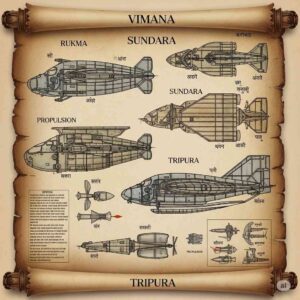
Description:
The Rukma Vimana is perhaps the most awe-inspiring of all Vimanas described in the Bharadwaja Vaimanika Shastra. It has a conical or cylindrical shape, resembling modern rockets.
Features:
-
Golden exterior, which inspired the name “Rukma” (meaning gold)
-
Capable of high-speed travel over great distances
-
Rotary engine mechanism and anti-gravity propulsion
-
Highly aerodynamic shape for space or upper-atmosphere travel
-
Advanced systems for heat and sound absorption
Function:
Designed for long-distance or interplanetary travel, hinting at Vedic India’s conceptual understanding of space travel.
Symbolism:
The Rukma Vimana may reflect the desire to conquer outer space, showcasing ancient India’s advanced imagination and technological prowess.
4. Tripura Vimana
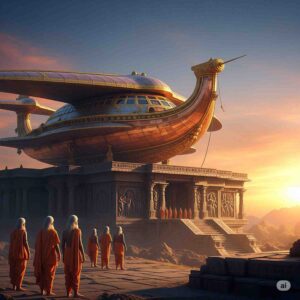
Description:
The Tripura Vimana is the most complex and mystical of all, possibly the ultimate flying fortress. Features:
-
Three separate floors, each functioning independently
-
Equipped with weapons, laboratories, and living quarters
-
Powered by solar energy, wind energy, and rare alchemical substances
-
Equipped with stealth systems to become invisible
-
Could split into separate units and reunite mid-air
Function:
Used for military missions, reconnaissance, and space exploration. A Vedic version of a modern aircraft carrier or space station.
Symbolism:
“Tripura” means three cities—indicating multifunctional use and holistic mastery over the three elements: earth, water, and sky.
Sub-Systems Mentioned in Bharadwaja Vaimanika Shastra
Apart from the Vimanas themselves, the Bharadwaja Vaimanika Shastra also describes various components and sub-systems that support Vimana technology:
-
Mirror and lens-based radar
-
Electricity generators using solar rays
-
Anti-gravity wheels and energy coils
-
Secret chemicals and alloys for fuel and structure
-
Mind-control systems for navigation
Each component has its name, specifications, and sometimes even mantras to activate or assemble it—further adding to the text’s enigmatic and spiritual flavor.
Modern Interpretations and Controversies
Many scholars and scientists have debated the authenticity of the Bharadwaja Vaimanika Shastra. Some claim it to be a 20th-century fabrication inspired by modern aviation, while others believe it contains encoded knowledge passed down through oral tradition.
Indian defense researchers have occasionally looked into these ancient texts to extract ideas for aerospace and energy solutions. ISRO and DRDO have not officially confirmed using this text, but independent scientists have tried to reconstruct Vimana blueprints based on the descriptions.
One cannot ignore the fact that the Bharadwaja Vaimanika Shastra contains technical diagrams, mechanical principles, and material specifications that challenge the mainstream narrative of India’s past as purely spiritual and philosophical.
Which Book Did Maharishi Bhardwaj Author?
Unveiling the Secrets of Bharadwaja Vaimanika Shastra
In the vast ocean of ancient Indian wisdom, one name shines brightly—Maharishi Bhardwaj. Revered as a sage, scientist, and seer, Maharishi Bhardwaj left behind a legacy that continues to mystify and inspire. Among the many profound contributions attributed to him, one particular text stands out due to its sheer complexity, futuristic ideas, and mysterious nature—the Bharadwaja Vaimanika Shastra.
But what exactly is the Bharadwaja Vaimanika Shastra? Why is it so important? And is it truly written by Maharishi Bhardwaj? In this in-depth exploration, we’ll dive into the origins, structure, controversies, and significance of the Bharadwaja Vaimanika Shastra, the book widely attributed to this legendary rishi.
Who Was Maharishi Bhardwaj?
Before understanding the Bharadwaja Vaimanika Shastra, it’s crucial to know who Maharishi Bhardwaj was. He was one of the revered Saptarishis (seven great sages) in ancient Hindu tradition. A brilliant mind, Bhardwaj was known for his mastery in diverse fields such as medicine (Ayurveda), astronomy, military science, and aviation—yes, aviation!
Legends describe him as a pioneer of ancient Indian science, with the power to perceive celestial truths and transcribe them for human understanding. His ashram in Prayagraj (ancient Prayag) was a hub of Vedic learning, attracting students and scholars from across the land.
The Bharadwaja Vaimanika Shastra: A Glimpse into Ancient Aviation
The Bharadwaja Vaimanika Shastra is arguably the most fascinating text attributed to Maharishi Bhardwaj. The title itself translates to “Science of Aeronautics by Bhardwaj”. It is said to contain detailed knowledge about ancient Indian flying machines called “Vimanas”.
Yes, you read that right. Long before the Wright brothers ever dreamed of flying, Maharishi Bhardwaj may have conceptualized machines that could fly—not only through the sky but even across planets and dimensions.
What’s Inside the Bharadwaja Vaimanika Shastra?
The Bharadwaja Vaimanika Shastra is a comprehensive treatise composed in Sanskrit and structured into eight chapters, comprising hundreds of sutras (aphorisms). The text is believed to discuss:
-
The construction of different types of Vimanas (aerial vehicles)
-
The materials used in their construction
-
Types of fuels and power sources
-
Pilot training and flight manuals
-
Stealth techniques, radar avoidance, and invisibility cloaking
-
Details of interplanetary travel
-
Anti-gravity and propulsion technologies
In essence, the Bharadwaja Vaimanika Shastra describes over 25 different types of aircraft, each with distinct specifications, functionalities, and uses. It also outlines various types of engines and mechanical components, some of which eerily resemble modern-day technology.
How Was the Bharadwaja Vaimanika Shastra Discovered?
The world first heard about the Bharadwaja Vaimanika Shastra in the early 20th century, when a Sanskrit scholar named Pandit Subbaraya Shastry claimed that he had received the manuscript through psychic revelations (known as Akashic downloads) from Maharishi Bhardwaj himself.
According to Shastry, he transcribed the ancient knowledge from higher dimensions as it was psychically dictated to him by the spirit of Maharishi Bhardwaj. The manuscript was completed around 1918 and was later published in 1959 by G.R. Josyer, who titled it “Vymanika Shastra of Maharshi Bharadwaja”.
Despite the controversy around its origins, the Bharadwaja Vaimanika Shastra gained massive attention, especially because of its detailed illustrations, technical depth, and its futuristic description of aircraft and aerospace science.
Is Bharadwaja Vaimanika Shastra Really Written by Maharishi Bhardwaj?
This is the million-dollar question. Did Maharishi Bhardwaj himself write the Bharadwaja Vaimanika Shastra, or is it a later creation inspired by his teachings?
There are two schools of thought:
1. Traditional View:
Many believe that Maharishi Bhardwaj originally wrote the Bharadwaja Vaimanika Shastra during the Treta Yuga or Dwapara Yuga, and that the knowledge was preserved through oral transmission and manuscript copies over the millennia. The content, they argue, is too advanced for early 20th-century forgery and must have originated in antiquity.
2. Modern Academic View:
Skeptics argue that the Bharadwaja Vaimanika Shastra may be a modern creation inspired by spiritualism and mythological interpretations. Scholars point to linguistic anomalies, technical inaccuracies, and the absence of the original manuscript as reasons to doubt its authenticity.
However, even critics admit that the Bharadwaja Vaimanika Shastra contains highly imaginative ideas that align with conceptual physics and aerospace design, which were unheard of in 1918 India.
Scientific Analysis of Bharadwaja Vaimanika Shastra
The Indian Institute of Science (IISc) in Bangalore conducted a study on the Bharadwaja Vaimanika Shastra in 1974. The researchers concluded that the described aircraft were aerodynamically unfeasible by modern standards.
However, this has not diminished the popularity of the Bharadwaja Vaimanika Shastra among alternative historians, Hindu scholars, and ancient astronaut theorists, who believe that ancient Indian sages possessed superior knowledge hidden within spiritual symbolism.
Modern Interpretations and Cultural Impact
The Bharadwaja Vaimanika Shastra continues to captivate scientists, philosophers, and conspiracy theorists alike. It has been referenced in:
-
Indian television shows like “Ancient Aliens”
-
Documentaries on Vedic science and UFOs
-
Research in alternative aviation theories
-
Indian defense and aerospace curiosity circles
Some even believe that the Bharadwaja Vaimanika Shastra contains encrypted instructions that could inspire future innovations in anti-gravity technology and non-combustion propulsion systems.
Why Is Bharadwaja Vaimanika Shastra Important Today?
In an age where science and spirituality often walk separate paths, the Bharadwaja Vaimanika Shastra stands as a unique bridge. Whether literal or metaphorical, its content forces us to:
-
Re-evaluate the depth of ancient Indian knowledge
-
Question the linear progression of science
-
Recognize the blend of spirituality and technology
-
Investigate whether intuitive science has a place in modern labs
The Bharadwaja Vaimanika Shastra may or may not be entirely factual in today’s terms, but it is undoubtedly one of the most visionary texts ever produced in ancient Indian history.
Who Wrote Ved Shastra? The Origins, Authors, and Mysteries Behind Ancient Indian Knowledge
The Ved Shastra, more commonly referred to as the Vedas, are the oldest sacred scriptures known to mankind. They form the foundational texts of Hinduism and are considered timeless, divine revelations passed on through generations. But one question has continued to baffle historians, scholars, and seekers of ancient wisdom: Who wrote Ved Shastra? Was it composed by mortal sages or delivered by cosmic entities? To understand the answer to this question, we must dig deep into ancient Indian texts, oral traditions, and esoteric teachings—some of which are linked to other legendary works like the Bharadwaja Vaimanika Shastra.
The Meaning and Significance of Ved Shastra
The term “Ved Shastra” translates to “science or treatise of knowledge.” The word “Veda” means knowledge, while “Shastra” denotes a discipline or scripture. The Ved Shastra comprises four main collections:
-
Rigveda
-
Samaveda
-
Yajurveda
-
Atharvaveda
Each of these Vedas has been further divided into four sections:
-
Samhitas – hymns of praise
-
Brahmanas – rituals and ceremonies
-
Aranyakas – theological teachings
-
Upanishads – spiritual knowledge and philosophy
Just as the Bharadwaja Vaimanika Shastra is believed to be a shastra of aeronautics, the Ved Shastra can be seen as the shastra of universal and spiritual knowledge. Both are said to have been revealed through divine inspiration and scribed by enlightened beings.
The Mythical Origins of the Vedas
According to Hindu tradition, the Vedas were not authored by any single human being. They were perceived (not written) by great seers known as Rishis in a meditative state. These Rishis include names like:
-
Vishwamitra
-
Vashistha
-
Bharadvaja
-
Atri
-
Gautama
-
Agastya
Among these, Rishi Bharadvaja is especially significant due to his connection with another ancient text – the Bharadwaja Vaimanika Shastra.
The Role of Rishi Bharadvaja
While many sages contributed to different Vedic hymns, one of the most prolific among them was Rishi Bharadvaja. He is credited with composing several hymns in the Rigveda and is revered for his profound knowledge of various sciences.
Rishi Bharadvaja’s contributions are not only found in the Ved Shastra but also in various ancient disciplines, including medicine, warfare, and aeronautics, as evidenced by the Bharadwaja Vaimanika Shastra.
The Bharadwaja Vaimanika Shastra is an ancient Sanskrit text that describes aerial vehicles called “Vimanas” – flying machines mentioned throughout Hindu mythology. Just as the Ved Shastra delivers spiritual and ritual knowledge, the Bharadwaja Vaimanika Shastra is a technical manual detailing the engineering principles of flying crafts.
The Compilation of the Vedas by Vyasa
Even though the Vedas were heard and passed on orally, the monumental task of compiling and classifying them into their four main divisions is credited to Maharishi Veda Vyasa. His role is crucial because, without his effort, the knowledge might have remained scattered and disorganized.
Vyasa organized the Vedas in a structured way and entrusted different disciples to carry forward each section:
-
Paila for Rigveda
-
Jaimini for Samaveda
-
Vaishampayana for Yajurveda
-
Sumantu for Atharvaveda
Though Vyasa compiled them, the original “writing” or “authoring” in the divine sense is still attributed to the Rishis who first perceived them—just as the Bharadwaja Vaimanika Shastra is considered
Oral Transmission: The Power of Shruti
The Vedas were transmitted orally for thousands of years using an intricate system of memorization known as Shruti (that which is heard). This system ensured near-perfect preservation of the texts for centuries, a feat that modern scholars find astonishing.
This oral tradition is also found in other ancient texts like the Bharadwaja Vaimanika Shastra, which may have been part of a larger body of lost knowledge passed down through generations before being transcribed into manuscripts.
The Bharadwaja Vaimanika Shastra is often seen as a continuation of the Vedic quest for universal knowledge. It suggests that ancient Indian sages were not just spiritual guides but also scientists, engineers, and innovators.
This overlap indicates that the Rishis had holistic knowledge that spanned spirituality and science. While the Vedas deal with mantras and rituals, the Bharadwaja Vaimanika Shastra delves into the scientific and technological capabilities of ancient India.
In fact, the Bharadwaja Vaimanika Shastra is often cited in modern discussions about ancient Indian aviation, pushing the boundaries of our understanding of Vedic science.
The Debate: Human Authorship vs. Divine Revelation
Scholars often argue over whether the Vedas were written by humans or divinely inspired. The same debate extends to texts like the Bharadwaja Vaimanika Shastra. Some claim that these texts are mythological or symbolic, while others believe they are blueprints of actual technologies that existed in ancient times.
In both cases, whether we look at the Ved Shastra or the Bharadwaja Vaimanika Shastra, the authorship is not merely a matter of who wrote the text but who received the knowledge.
Modern Research and Relevance
In recent times, texts like the Bharadwaja Vaimanika Shastra have gained attention for potentially containing knowledge ahead of their time. Similarly, the Ved Shastra is being studied not just for its religious value but for its insights into psychology, cosmology, and quantum philosophy.
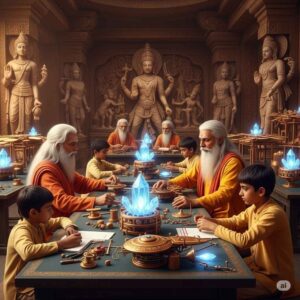
The resurgence of interest in these ancient scriptures is reigniting debates and encouraging new research into ancient Indian science. Whether it’s Vedic chants used in healing practices or the aeronautical theories found in the Bharadwaja Vaimanika Shastra, the legacy of these ancient texts continues to thrive.
Who is the Father of Bharadwaja?
Uncovering the Ancient Legacy Behind the Author of Bharadwaja Vaimanika Shastra
India is a land of sages, wisdom, ancient scriptures, and mysterious science. One such enigma is the Bharadwaja Vaimanika Shastra, a text that speaks of ancient aeronautics, flying machines, and lost technological marvels. But behind this incredible treatise lies a powerful personality—Maharshi Bharadwaja, the legendary sage and scholar.
To truly understand the origins of the Bharadwaja Vaimanika Shastra, it becomes important to explore the ancestry and spiritual legacy of its author. This brings us to an intriguing question:
Who is the father of Bharadwaja?Let’s dive deep into the roots of the sage who gave India the Bharadwaja Vaimanika Shastra, and explore the fascinating tales from the Vedic era that surround his divine lineage.
The Sage Behind Bharadwaja Vaimanika Shastra
Before we uncover who fathered Bharadwaja, let us revisit what makes him so special. Sage Bharadwaja is hailed as one of the Saptarishis (seven great sages) in Hindu tradition. His contributions to Indian philosophy, Ayurveda, astronomy, and ancient science are immense. The Bharadwaja Vaimanika Shastra stands as his most debated and mysterious legacy, especially in modern times, where ancient science is being re-evaluated with a new lens.
The Bharadwaja Vaimanika Shastra has brought Sage Bharadwaja into global focus. This ancient manuscript, attributed to him, contains detailed descriptions of flying machines—Vimanas—long before the Wright brothers even dreamed of flight. The very existence of the Bharadwaja Vaimanika Shastra makes people question: how advanced was ancient India?
And who was the man who raised such a visionary?
Who Was the Father of Sage Bharadwaja?
According to ancient Hindu scriptures, Sage Brihaspati is said to be the father of Bharadwaja.
Brihaspati – The Guru of the Gods
Brihaspati is no ordinary being. He is the celestial teacher of the Devas (gods), the guru of Indra, and a master of knowledge, philosophy, and metaphysics. Brihaspati is considered one of the greatest rishis (seers) in Vedic tradition and is credited with composing several hymns in the Rigveda.
It’s no wonder that someone born to Brihaspati would possess the divine intellect to author the Bharadwaja Vaimanika Shastra.
The Birth Story of Bharadwaja – A Celestial Origin
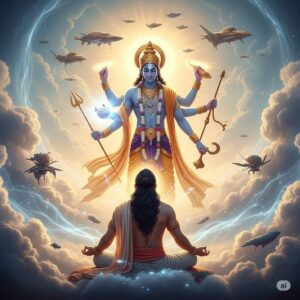
The story of Bharadwaja’s birth is filled with divine intervention and mysticism, much like the Bharadwaja Vaimanika Shastra itself.
According to ancient texts like the Mahabharata and various Puranas, Sage Bharadwaja was born under unusual circumstances. In one version of the legend, Brihaspati, while performing sacred rituals near the Ganga River, saw a celestial nymph or apsara named Mamatha, the wife of Utathya. Overwhelmed by desire, Brihaspati approached her, and from this union, Bharadwaja was born.
In another version, Bharadwaja is said to have been born from a divine sperm drop preserved by the winds and delivered to a sacred fire, where he manifested miraculously.
These mythological versions may differ, but one fact remains consistent—Bharadwaja was the spiritual son of Brihaspati, and this lineage explains his incredible intellect and vision.
The Divine Lineage and the Genius of Bharadwaja
Being born to Brihaspati, Bharadwaja inherited an unmatched celestial wisdom. His works, including the Bharadwaja Vaimanika Shastra, are filled with concepts that modern scientists still struggle to decode.
Why Does the Father Matter?
Understanding Bharadwaja’s father helps us place the Bharadwaja Vaimanika Shastra in its proper spiritual and intellectual context. It wasn’t created in isolation.
This is not just about familial ties—it’s about divine knowledge being passed through ancient Rishi parampara (sage tradition), where the universe itself was the classroom and the cosmos was the textbook.
Bharadwaja Vaimanika Shastra – A Legacy of Celestial Knowledge
Let’s bring the focus back to the Bharadwaja Vaimanika Shastra. Why is this text so legendary?
It contains:
-
Detailed designs of vimanas (flying machines).
-
The principles of aerodynamics, propulsion, and pilot training.
-
Descriptions of metals and materials to be used in vimanas.
-
Instructions on energy sources, including solar, electric, and mercury-based engines.
All this was written long before modern science even conceptualized aircraft. The brilliance behind Bharadwaja Vaimanika Shastra stems directly from the spiritual legacy of his father, Brihaspati, the guru of the gods.
Debates Around the Text – Ancient Wisdom or Later Compilation?
Scholars continue to debate whether the Bharadwaja Vaimanika Shastra was truly composed during the Vedic period or compiled much later. Regardless of its dating, the text attributes its knowledge to Sage Bharadwaja, and his authorship remains central to its identity.
Even if the actual transcription came in later centuries, the intellectual property of the Vimanika Shastra belongs to the mind of Maharshi Bharadwaja, who, as the son of Brihaspati, had access to divine wisdom.
Bharadwaja’s Role Beyond the Vaimanika Shastra
Though the Bharadwaja Vaimanika Shastra is the most famous text linked to him today, Bharadwaja’s contributions stretch far beyond.
He authored:
-
Ayurveda treatises, some lost and some preserved.
-
Texts on military science and weaponry.
-
Philosophical discourses on dharma and yoga.
His role in mentoring future sages like Dronacharya (teacher of the Pandavas and Kauravas in Mahabharata) further proves how deep and wide his wisdom spread.
And all this is the fruit of a lineage that began with Brihaspati, the universal guru.
Introduction to Sage Bharadwaja
Maharishi Bharadwaja is one of the seven great rishis (Saptarishis) and a revered figure in Vedic literature. His name appears in the Ramayana, Mahabharata, and several ancient scriptures like the Rigveda, the Puranas, and the Upanishads. He is known for his immense contributions to philosophy, science, and spirituality.
In the context of the Ramayana, Maharishi Bharadwaja appears during a pivotal moment in the life of Lord Rama, Sita, and Lakshmana, offering not just guidance but also divine hospitality and blessings.
Lineage of Sage Bharadwaja
Sage Bharadwaja belonged to the Angirasa gotra, a spiritual lineage descending from Sage Angiras, one of the Saptarishis. According to legends:
-
His father is often said to be Devarishi Brihaspati, the guru of the gods.
-
Some versions also describe him as being born from the sacred flames of a yajna conducted by King Bharata or by the grace of the gods themselves.
-
In many texts, he is considered the spiritual father of Drona, the military preceptor in the Mahabharata.
Thus, Bharadwaja connects the divine past with both the Ramayana and Mahabharata, making him a pivotal figure in ancient Indian lore.
Bharadwaja in the Ramayana
1. The Meeting with Lord Rama
Sage Bharadwaja’s most well-known appearance in the Ramayana occurs when Lord Rama, along with Sita and Lakshmana, is exiled to the forest for fourteen years. As they journey south from Ayodhya, they arrive near the banks of the Yamuna River, close to Prayag (modern-day Prayagraj). There, they visit the ashram of Sage Bharadwaja.
The sage warmly welcomes Rama and his companions with great respect and divine hospitality.
2. Divine Hospitality and Guidance
Although they initially decline his luxurious arrangements in favor of a simple forest life, the sage insists and arranges a divine feast and celestial comforts, invoking the apsaras and gandharvas to serve them.
This shows the deep reverence sages had for dharma, and how even great spiritual beings felt honored to host avatars like Lord Rama. After the hospitality, Bharadwaja guides them to proceed to Chitrakoot, a scenic place ideal for their forest stay. It is on Bharadwaja’s advice that they choose this spot, which later becomes one of the most sacred places associated with Lord Rama.
3. Spiritual Significance
The presence of Maharishi Bharadwaja in the Ramayana is not just a narrative event. It represents:
-
The integration of Vedic wisdom and dharmic life
-
The acknowledgment of Rama’s divinity by great sages
-
The network of enlightened beings protecting dharma through spiritual support
Bharadwaja’s Ashram – A Place of Pilgrimage
This place is still revered and visited by pilgrims from across India.
The ashram served not just as a home for the sage, but also as a center of knowledge, meditation, and Vedic studies.
Bharadwaja’s Contributions to Vedic Knowledge
Outside the Ramayana, Maharishi Bharadwaja is famous for his contributions to Indian science, medicine, and spirituality. Some of his legendary contributions include:
1. Vedic Hymns
These hymns touch on spiritual, natural, and moral themes.
2. Bharadwaja Samhita
This is a lesser-known but important text attributed to him, dealing with medicine and Ayurveda. It is believed that he taught the science of medicine to Atreya, who in turn taught it to Charaka, the author of the famous Charaka Samhita.
3. Bharadwaja Vaimanika Shastra
One of the most mysterious works associated with Bharadwaja is the Vaimanika Shastra, an ancient treatise on aeronautics and flying machines (vimanas). Though debated in terms of authenticity and dating, this text has become a centerpiece in discussions about ancient Indian science and advanced technology.
4. Contributions to Dhanurveda and Yoga
He is also mentioned in traditional texts of Dhanurveda (martial arts) and yoga. His name often comes up in the context of divine wisdom and astral sciences.
Bharadwaja and the Mahabharata Connection
This connection makes Bharadwaja a key figure across both epics, symbolizing the continuity of Vedic knowledge through generations.
Bharadwaja – Symbol of Wisdom and Dharma
In every role he plays—whether as a host to Rama, father of Drona, or compiler of sacred hymns—Bharadwaja represents the timeless Indian ideal of the enlightened rishi. He is the embodiment of tapasya (penance), jnana (wisdom), and seva (service to dharma).
Legacy in Indian Culture and Temples
Today, Sage Bharadwaja is worshipped and remembered in various parts of India:
-
Temples dedicated to him exist in Prayagraj, Tamil Nadu, and Andhra Pradesh.
-
The Bharadwaja Gotra is one of the most prominent spiritual lineages among Hindus, especially Brahmins.
-
Many Indian families trace their spiritual ancestry to this great rishi.
-
Who Wrote Shastra? The Mystical Origins of India’s Ancient Knowledge
In the vast ocean of ancient Indian wisdom, one term appears repeatedly across disciplines: Shastra. But who wrote Shastra? Where did these intricate treatises on everything from warfare and architecture to medicine and spirituality come from? The term “Shastra” is not a singular book or manual but a vast collection of texts spanning centuries, civilizations, and schools of thought. Let’s journey through ancient India to uncover the mysterious and divine origins of the Shastras.
What Does “Shastra” Mean?
Before we can understand who wrote Shastra, we must understand what the term actually means.
-
Artha Shastra – on statecraft and economics
-
Ayurveda Shastra – on health and medicine
-
Dhanurveda Shastra – on warfare and weapons
-
Vaimanika Shastra – on aeronautics and flying machines
-
Natya Shastra – on performing arts
Each of these Shastras was not a random collection of ideas but carefully written, structured, and transmitted over generations. So now the big question is: Who were the ancient minds behind these incredible works?
Who Wrote the Shastras?
There is no single author of “Shastra.” Instead, many sages, rishis, and scholars from ancient India contributed to various Shastras based on their fields. Here are some of the most legendary names in Indian history connected to different Shastras:
1. Maharishi Bharadwaja – The Vaimanika Shastra
One of the most mysterious and debated Shastras is the Vaimanika Shastra, which deals with ancient flying machines or Vimanas. The text is attributed to Maharishi Bharadwaja, a sage from the Rigvedic period. He is considered one of the Sapta Rishis (seven sages) and is also credited with authoring parts of the Rig Veda.
The Vaimanika Shastra, supposedly written by Bharadwaja, is said to contain detailed instructions for building flying vehicles powered by mercury and centrifugal forces. Though modern scholars argue about the authenticity and practicality of the text, it remains one of the most fascinating documents tied to the ancient astronaut theory.
2. Kautilya (Chanakya) – The Artha Shastra
Another major figure in ancient Indian history, Kautilya (also known as Chanakya or Vishnugupta), wrote the Artha Shastra—a treatise on statecraft, politics, diplomacy, and economics. Composed around the 4th century BCE during the Maurya Empire, this Shastra outlines the duties of a king, taxation systems, laws, foreign policy, espionage, and warfare.
Kautilya was the chief advisor to Chandragupta Maurya, and his Artha Shastra is a monumental work that shows how advanced Indian political thinking was even in ancient times.
3. Bharata Muni – The Natya Shastra
For those asking who wrote Shastra in the field of arts and drama, the answer is Bharata Muni. He is credited with authoring the Natya Shastra, the foundational text of Indian classical dance, drama, and music. This comprehensive work includes everything from costume design and stage structure to hand gestures and emotional expressions.
Interestingly, the Natya Shastra is said to have been revealed to Bharata by Lord Brahma himself, making it a divine gift to humanity for the purposes of education and entertainment.
4. Sushruta and Charaka – The Ayurveda Shastras
The Ayurveda Shastras—which deal with holistic healing, surgery, and lifestyle science—are attributed mainly to Charaka and Sushruta.
-
Sushruta, known as the father of surgery, wrote the Sushruta Samhita, which describes over 300 surgical procedures and more than 120 surgical instruments.
Both of these Shastras are still referred to in modern Ayurveda practices.
5. Parashara – Dharma Shastra and Jyotish Shastra
Parashara, another ancient sage, is known for his work in Jyotish Shastra (astrology) and Dharma Shastra (laws and ethics). His work Brihat Parashara Hora Shastra is a crucial text in Vedic astrology.
He also influenced Parashara Smriti, a text on righteous conduct and duties, making him a central figure in shaping both cosmic understanding and human behavior.
Were the Shastras Written by Humans or Divinely Inspired?
In ancient India, many Shastras were considered “Apaurusheya”—meaning “not of human origin.” They were believed to be divinely revealed to sages during deep meditative states. The Vedas themselves, the root of all Indian spiritual and scientific knowledge, are considered revealed truths (Shruti), not man-made texts (Smriti).
This leads to the idea that the Shastras were written by Rishis under divine inspiration, often credited to deities like Brahma, Vishnu, or Shiva. In many cases, even if a human name is associated with a Shastra, the knowledge is seen as coming from a higher cosmic intelligence.
Transmission of Shastras – Guru to Disciple
Ancient India didn’t have printing presses. The knowledge contained in Shastras was passed on orally, from Guru to Shishya (disciple). This process ensured that the knowledge was preserved with exact precision, and often, with deep interpretation and experience.
In fact, the oral tradition (Shruti and Smriti) ensured the survival of the Shastras for thousands of years, even before they were eventually written on palm leaves and other materials.
Lost Shastras – Knowledge That Disappeared
Here’s where the mystery deepens. Many believe that countless Shastras have been lost to time, especially after repeated invasions, colonization, and destruction of ancient libraries like Nalanda and Takshashila.
-
The burning of these ancient Indian universities likely destroyed thousands of manuscripts.
-
It’s said that only a fraction of the original Shastric knowledge survives today.
-
There are references in remaining texts about other Shastras that are now missing.
This has given rise to legends of hidden libraries, secret societies like the Nine Unknown Men, and ancient manuscripts buried under temples.
The Role of Shastras in Modern India

Even today, Shastras influence Indian law, medicine, architecture (Vastu Shastra), and spiritual practices. Modern scientists and researchers are revisiting Shastras to find inspiration for futuristic technologies.
For example:
-
The Bharadwaja Vaimanika Shastra has sparked interest in anti-gravity and aerodynamics.

